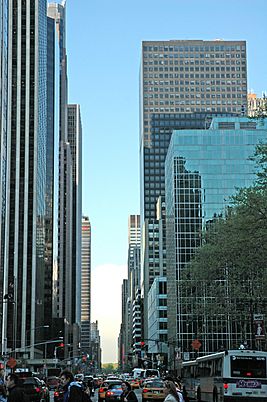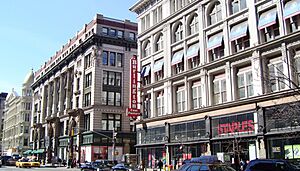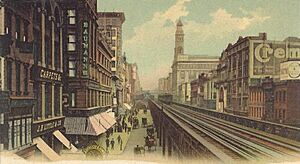Sixth Avenue facts for kids

The "skyscraper alley" of International Style buildings along the avenue looking north from 40th Street to Central Park
|
|
| Other name(s) | Avenue of the Americas |
|---|---|
| Namesake | The Americas |
| Owner | City of New York |
| Maintained by | NYCDOT |
| Length | 3.7 mi (6.0 km) |
| Location | Manhattan, New York City |
| South end | Church / Franklin Streets in Tribeca |
| Major junctions |
Herald Square in Midtown |
| North end | Central Park South / Center Drive in Midtown |
| East | Fifth Avenue (north of Waverly Pl) |
| West | Varick Street (south of Houston Street) Seventh Avenue (Houston Street to 34th Street) Broadway (between 34th and 45th Streets) Seventh Avenue (between 45th and 59th Streets) |
| Construction | |
| Commissioned | March 1811 |
Sixth Avenue, also known as Avenue of the Americas, is a major street in Manhattan, one of New York City's five boroughs. Traffic on this street mostly goes north, or "uptown." Many businesses and shops are found along this busy street.
Sixth Avenue starts in an area called Tribeca, a few blocks south of Canal Street. It begins where Church Street splits into two. From there, Sixth Avenue goes through neighborhoods like SoHo and Greenwich Village. It also separates Chelsea from the Flatiron District and NoMad. Further north, it passes through the Garment District and near the Theater District in Midtown Manhattan. Even though its official name is "Avenue of the Americas," most New Yorkers still call it "Sixth Avenue."
The northern end of Sixth Avenue is at Central Park South, right next to the Artists' Gate entrance to Central Park. Long ago, the part of Sixth Avenue north of Central Park was renamed Lenox Avenue in 1887. Later, in 1987, it was also named Malcolm X Boulevard to honor the civil rights leader Malcolm X.
Contents
History of Sixth Avenue

Sixth Avenue was first planned in 1811 as part of a big city map. Originally, it was supposed to go from Carmine Street in Greenwich Village all the way north to 147th Street in Harlem. When Central Park was built in 1857, it created a gap in Sixth Avenue between 59th and 110th Streets.
In 1878, an elevated railway (a train track built above the street) called the "El" was built along Sixth Avenue. This made the street darker and less valuable for businesses. In the early 1800s, a popular place called Old Grapevine, a roadhouse and tavern, was located on Sixth Avenue at 11th Street. This was considered the northern edge of the city back then.
In 1887, the part of Sixth Avenue in Harlem was renamed Lenox Avenue to honor a kind person named James Lenox. A hundred years later, it was also named Malcolm X Boulevard.
Extending the Avenue Southward
Starting in 1926, as part of building the Holland Tunnel, Sixth Avenue was made wider and extended south from Minetta Lane to Canal Street. Smaller streets in the way were removed or became part of the new, longer avenue. This extension also allowed for a new subway line, the IND's Eighth Avenue Line, to be built under Sixth Avenue south of Eighth Street.
To make way for the subway, many buildings were torn down. About ten thousand people had to move from their homes. Many of these people were Italian immigrants who had lived there for a long time. The extension opened to traffic in 1930, and the subway line was finished two years later. This made Sixth Avenue the only numbered avenue in Manhattan to go south of Houston Street.
Changes in the 20th Century
By the 1930s, businesses and building owners along Sixth Avenue wanted the elevated train removed. The "El" closed on December 4, 1938, and was taken down in parts, starting in Greenwich Village. A new subway line, the IND Sixth Avenue Line, opened in 1940. It ran underground between Houston and 53rd Streets.
After the elevated train was gone, more businesses and tall buildings started to appear in Midtown. From the 1960s onward, the avenue above 42nd Street was rebuilt with many modern glass skyscrapers. These buildings became headquarters for large companies. Famous examples include the CBS Building at 52nd Street, known as "Black Rock," and the "XYZ Buildings" (1971–1974) at 1211, 1221, and 1251 Sixth Avenue.
In 1957, Sixth Avenue became a one-way street for northbound traffic north of Broadway in Herald Square. The rest of the avenue became one-way in 1963. In the mid-1970s, the city made the street look nicer by adding patterned brick walkways, repainting streetlights, and creating new public spaces for people to relax.
Renaming the Avenue

In 1945, the city officially changed the avenue's name to Avenue of the Americas. This was done by Mayor Fiorello La Guardia to honor the countries of North, Central, and South America. The idea was to make the street feel grander and encourage these countries to open consulates (offices for their governments) there.
After the name change, round signs with the national symbols of different American countries were put on streetlights. However, most New Yorkers kept calling it "Sixth Avenue." In 1955, a study found that people used "Sixth Avenue" much more often. Many people also wanted to go back to the original name.
Today, the street is labeled as both "Avenue of the Americas" and "Sixth Avenue." Many of the old round signs with country emblems disappeared over time. But starting in March 2023, the city began putting up new signs along most of the avenue, replacing the old ones that were still there.
Places to See and Events
Along Sixth Avenue, you can see many interesting places:
- Juan Pablo Duarte Square: A public square.
- The Jefferson Market Library: A colorful, old building that used to be a courthouse.
- The Ladies' Mile Historic District: This area from 18th Street to 23rd Street has many grand department store buildings from the late 1800s.
- Herald Square at 34th Street: Home to the famous Macy's department store.
- Bryant Park: A lovely park located between 40th and 42nd Streets.
- Many tall corporate buildings above 42nd Street, including the Bank of America Tower, W. R. Grace Building, International Center of Photography, and parts of Rockefeller Center (like the Time-Life Building, News Corp. Building, Exxon Building, McGraw-Hill Building, and Radio City Music Hall).
- The CBS Building: Also known as "Black Rock."
Sixth Avenue is also where two big parades happen each year:
- The annual Village Halloween Parade in Greenwich Village.
- The Dominican Day Parade in Midtown.
Getting Around on Sixth Avenue
Sixth Avenue has several ways to get around using public transportation:
- The New York City Subway's IND Sixth Avenue Line (B D F M trains) runs under the avenue north of Houston Street.
- The IND Eighth Avenue Line (A C E trains) serves the avenue south of Greenwich Avenue.
- The Harlem part of Sixth Avenue (Lenox Avenue) is served by the IRT Lenox Avenue Line (2 and 3 train) north of Central Park North (110th Street).
- The PATH train, which goes to New Jersey, also runs under Sixth Avenue (Template:NYCS JSQ–33 trains, Template:NYCS HOB-33 trains, and Template:NYCS JSQ-33 (via HOB) trains trains) from 9th to 33rd Streets.
Sixth Avenue in Pop Culture
The street is mentioned in the song "6th Avenue Heartache" by the band The Wallflowers.
See also
 In Spanish: Sexta Avenida (Manhattan) para niños
In Spanish: Sexta Avenida (Manhattan) para niños



